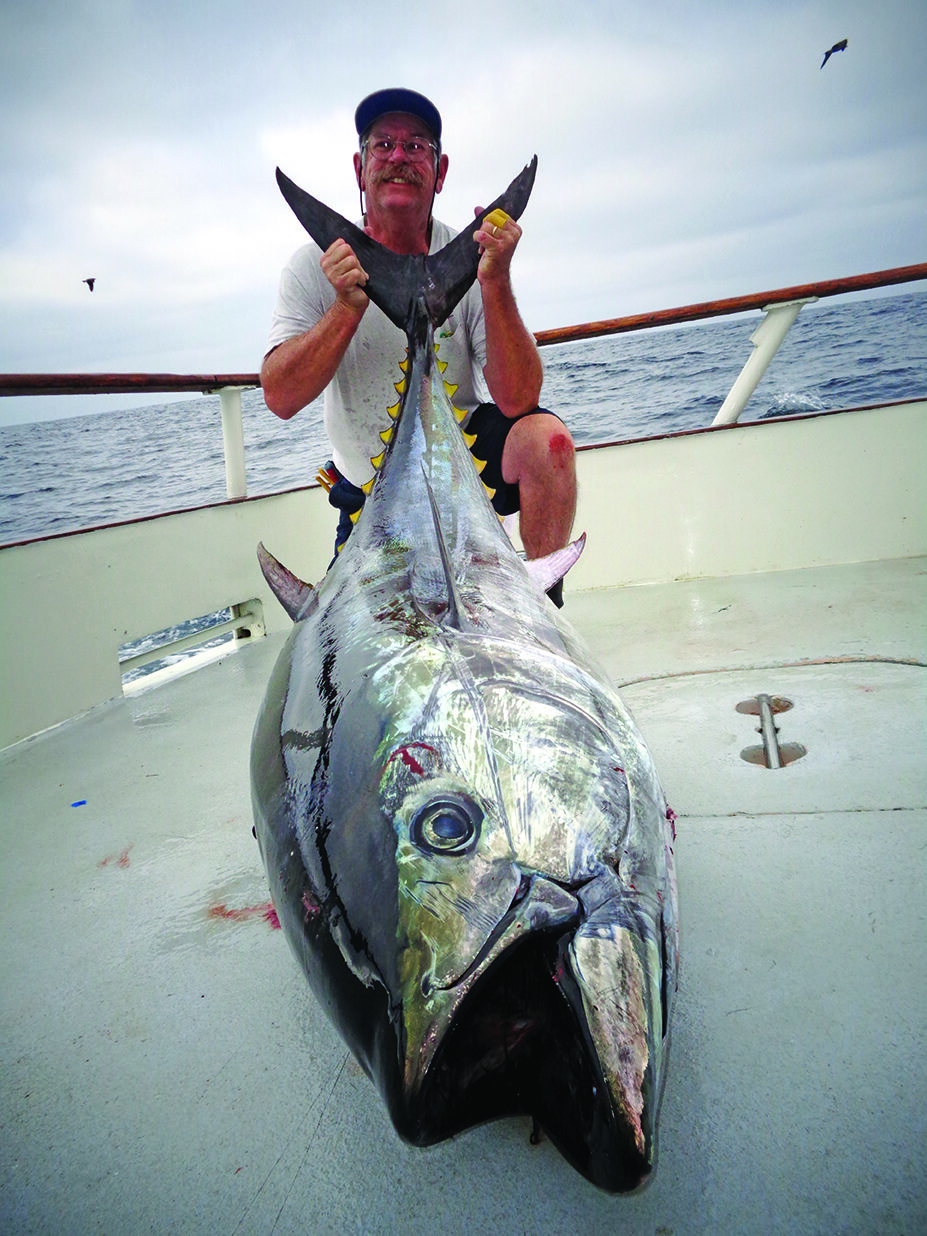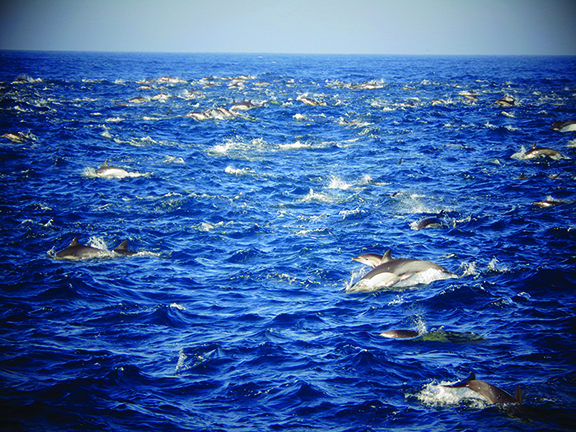 The 24 PENN Fishing University anglers who headed out for an 8-day long-range adventure aboard Captain Ray Lopez’ American Angler from Point Loma Sportfishing in San Diego knew they would be faced with a dilemma. Head deep into Baja waters to take a chance at tropical exotics like wahoo, or just go partway down, and then come back into US waters for a shot at big bluefin tuna.
The 24 PENN Fishing University anglers who headed out for an 8-day long-range adventure aboard Captain Ray Lopez’ American Angler from Point Loma Sportfishing in San Diego knew they would be faced with a dilemma. Head deep into Baja waters to take a chance at tropical exotics like wahoo, or just go partway down, and then come back into US waters for a shot at big bluefin tuna.
YELLOWTAIL, YELLOWTAIL, YELLOWTAIL
Captain Lopez opted to head south immediately upon departure, and after cruising all night, the next two full days were a blur of wide-open yellowtail, sprinting crewmen, and fish being dropped in the RSW hold. Moving among coastal hotspots meant as one area’s bite slowed down, a timely move would put the boat onto another voracious school.
The coastal-grade yellowtail were mostly all nice taggable 12-20 pounders, with a sprinkling of bigger ones up to 25 pounds. The most productive method was yo-yo iron, but surface iron, flylined sardines, sliding sinker rigs, Slow-Pitch jigs, and dropper loop rigs all scored decent numbers of fish.
For the anglers who were interested, a number of bonus species were available along with the yellows. Bruiser-grade calico bass were the most enticing, along with sheephead averaging well over 10 pounds. Plenty of whitefish, sand bass, barracuda, and bonito eagerly attacked jigs and bait intended for yellowtail, though virtually all of these species were safely released.
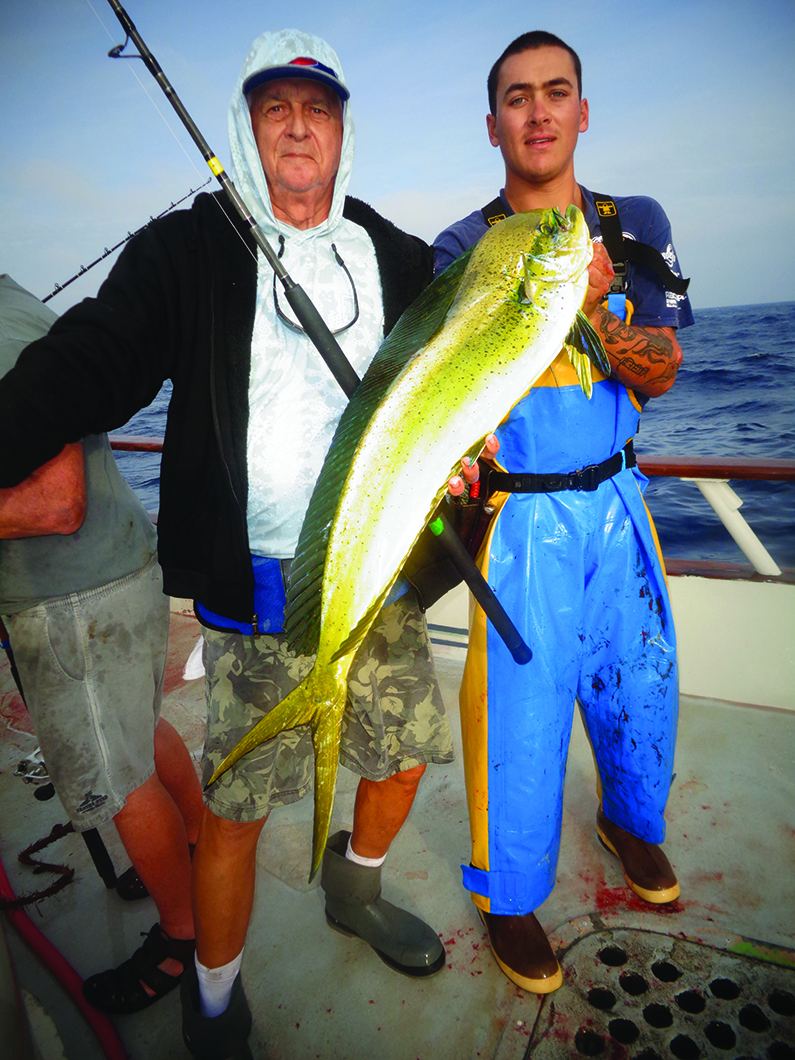 DECISION TIME
DECISION TIME
After two days of the excellent coastal yellowtail action, a fundamental decision had to be made. Captain Lopez informed us that the boats south of us at Alijos Rocks and The Ridge were experiencing modest action at best, with only a handful of wahoo, along with relatively small-size tuna and yellowtail hitting the decks.
Meanwhile, boats closer to home at the Tanner and Cortez Banks were getting into quality-grade bluefin tuna. If the group wanted a shot at those bluefin, turning around right then was a must. Accordingly, the decision was made, and the American Angler pointed her bow north.
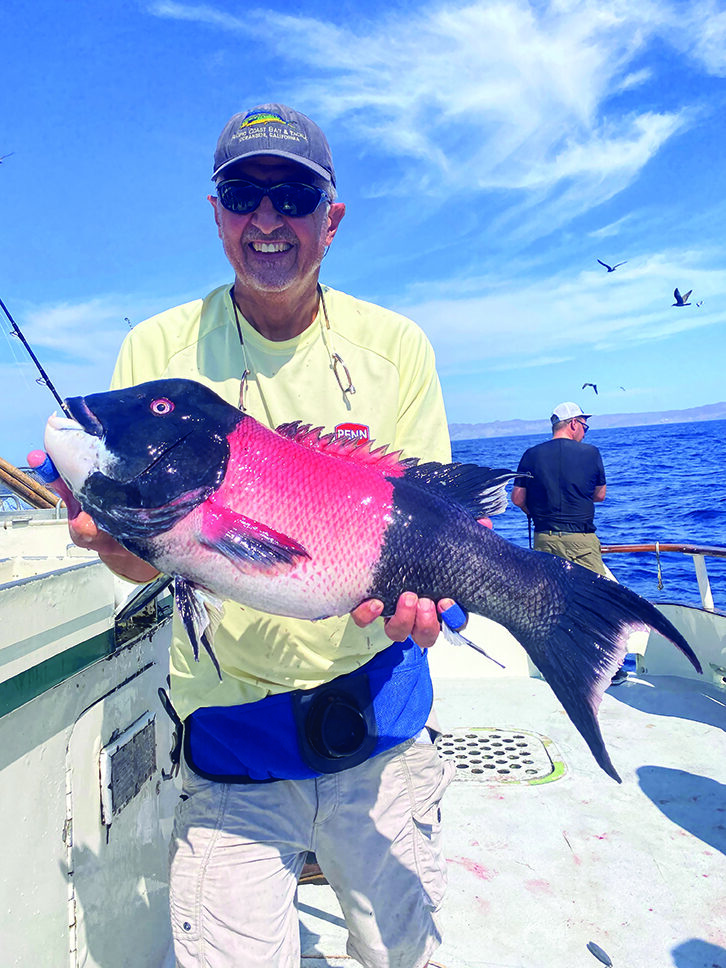 KELP PADDY MAYHEM
KELP PADDY MAYHEM
As the boat headed north toward the bluefin grounds, the kind of hotel-size kelp paddy everyone hopes for appeared off the bow. As Captain Lopez expertly spun the American Angler into position, a massive school of dorado charged out from under the paddy and directly at the boat.
Dorado in that kind of a frenzy are not selective at all about what pound test line, or what hook size an angler is using. A live [or even dead] sardine was gobbled up instantly upon hitting the water. However, safety etiquette dictates that lures are not used, since a leaping dorado can easily throw the lure, resulting in a dangerous missile zooming directly back at the boat.
This batch of dorado did not contain any lunkers, but the group easily landed their legal limit of delicious 12-20 pounders. After cleaning up the carnage, and tagging and dropping the dorado into the RSW hold, the American Angler resumed heading north.
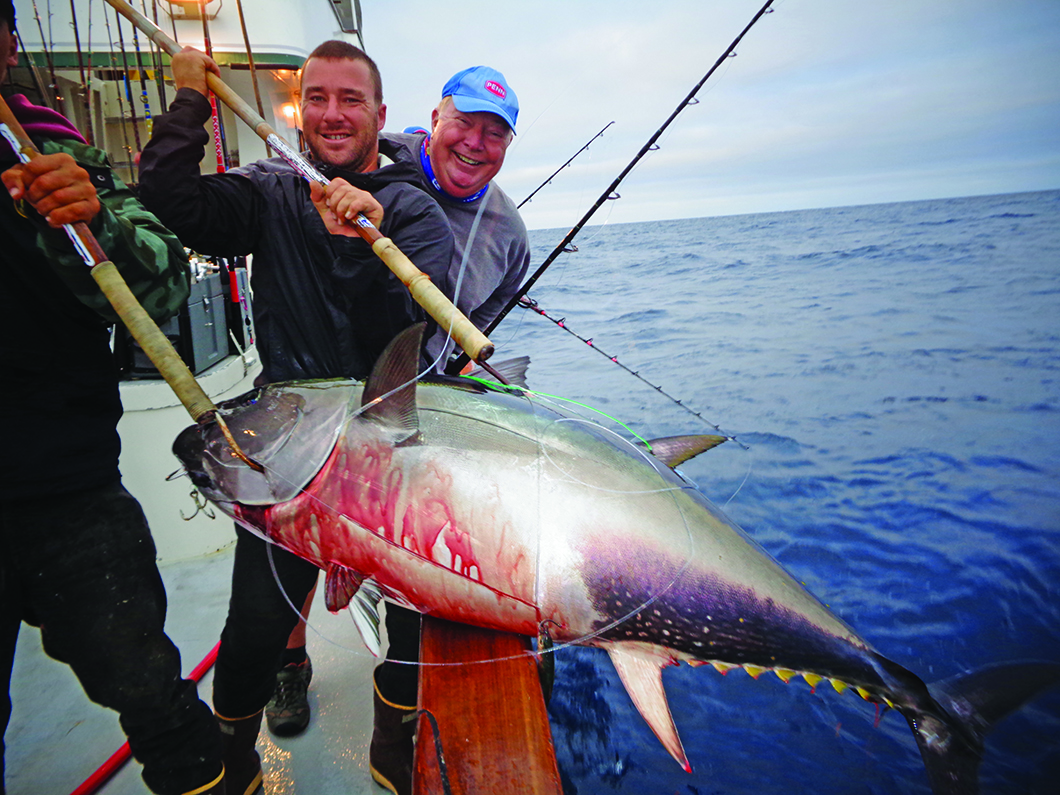 BLUEFIN CITY
BLUEFIN CITY
Arriving in the vicinity of San Clemente Island saw the crew deploy frozen flying fish on the boat’s kite rig. Almost immediately, a huge bluefin tuna responded. Being first on the kite rotation paid off big time for Gordon Brofft, who landed a monster 265-pounder after a brutal fight.
After that, bluefin of 179, 172, and 157 pounds followed in fairly short order on the frozen flying fish before the bite died down. At dusk, a 30-minute flurry of 90-100 pound bluefin responded to fall-type jigs.
The following day saw the overall action slow down, but some finicky 50-80 pound yellowfin tuna were around, and the group managed to land eight of these nice fish, plus a single school-size bluefin.
The final day of fishing found a fresh batch of school-size 20-40 pound bluefin at the Osborne Bank, and 32 of these nice-grade tuna were landed. Due to the light tackle necessary to coax a bite, a larger than normal proportion of fish were lost in order to land that total number.
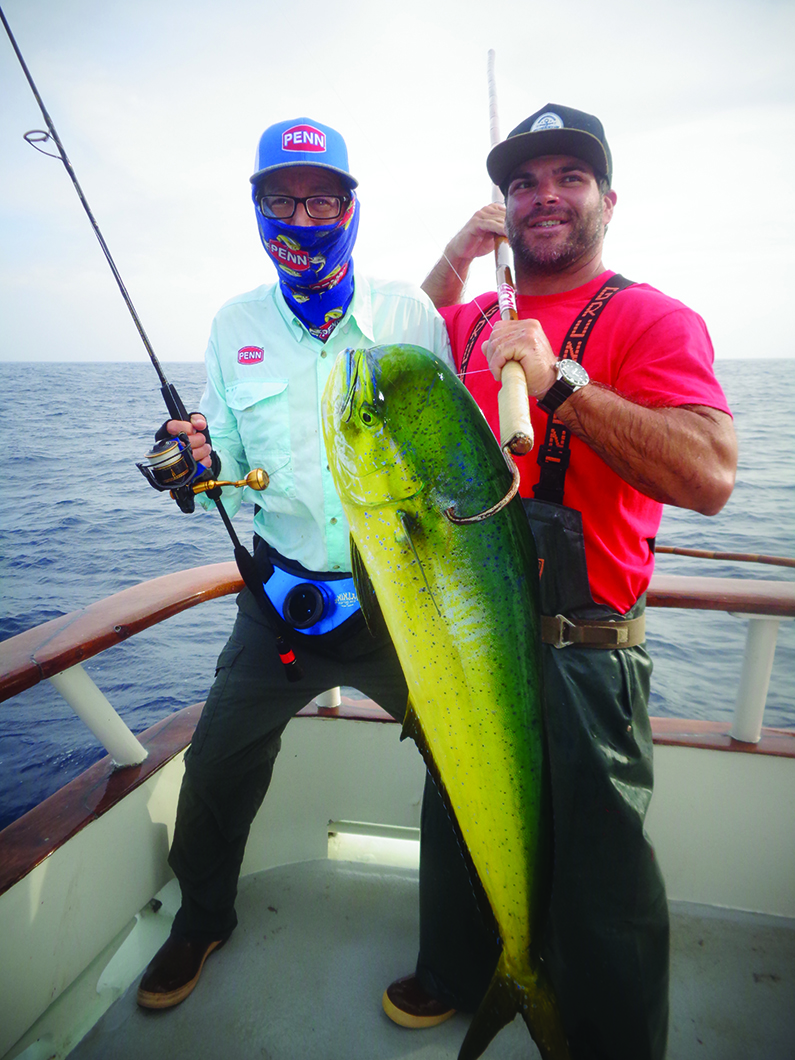 SAGE OBSERVATIONS
SAGE OBSERVATIONS
One of the most experienced long-rangers aboard this trip was Walt Bailey, owner of Pacific Coast Bait & Tackle in Oceanside. He observed: “This trip held a lot of excitement; there was always something happening. We got to fish every day except departure day; seven solid days of fishing on an eight-day trip. The crew really busted their butts to make sure everything went perfectly. I managed to catch five bluefin tuna up to 157 pounds, a limit of yellowtail, a 65-pound yellowfin tuna, and even a 12-pound sheephead.”
Bailey continued, “The biggest mistake I see people make when preparing for a trip like this is not planning ahead. Among the most common errors is not having the reels full-up with line. If a reel is only half full of line, it won’t cast right, and the drag won’t work right. Once you walk onboard, don’t be afraid to ask for help, the crew of the American Angler are some of the best professionals in the world.”
FIELD TESTING
Several new and upcoming PENN products were seen by the public for the first time on this trip. Most popular were the Fathom Low-Profile baitcast-style reels. Designed to be saltwater-specific instead of primarily for freshwater bass, the Low-Pro’s performed admirably, and successfully boated a number of yellowtail and dorado. The Fathom FTH400LP model filled with 50-pound braid will likely prove to be very popular for anglers chasing a variety of California and Baja fish species up to 50 pounds or even more.
Also making their debut were the specialized PENN rods and reels for Slow-Pitch Jigging. This technique is relatively new to California anglers, though it has been popular in Asia for over a decade. This trip produced some yellowtail on the Slow-Pitch Jigs, but large quantities of “by catch” like calico bass, bonito, and barracuda were encountered to keep the testing from being definitive.
As always, a large selection of PENN rod/reel setups were available for anglers to try out. The “demonstrator” rigs included 2-speed Internationals and Fathoms for everything from 40 to 100-pound lines, along with star drag Fathoms in the lighter line classes.
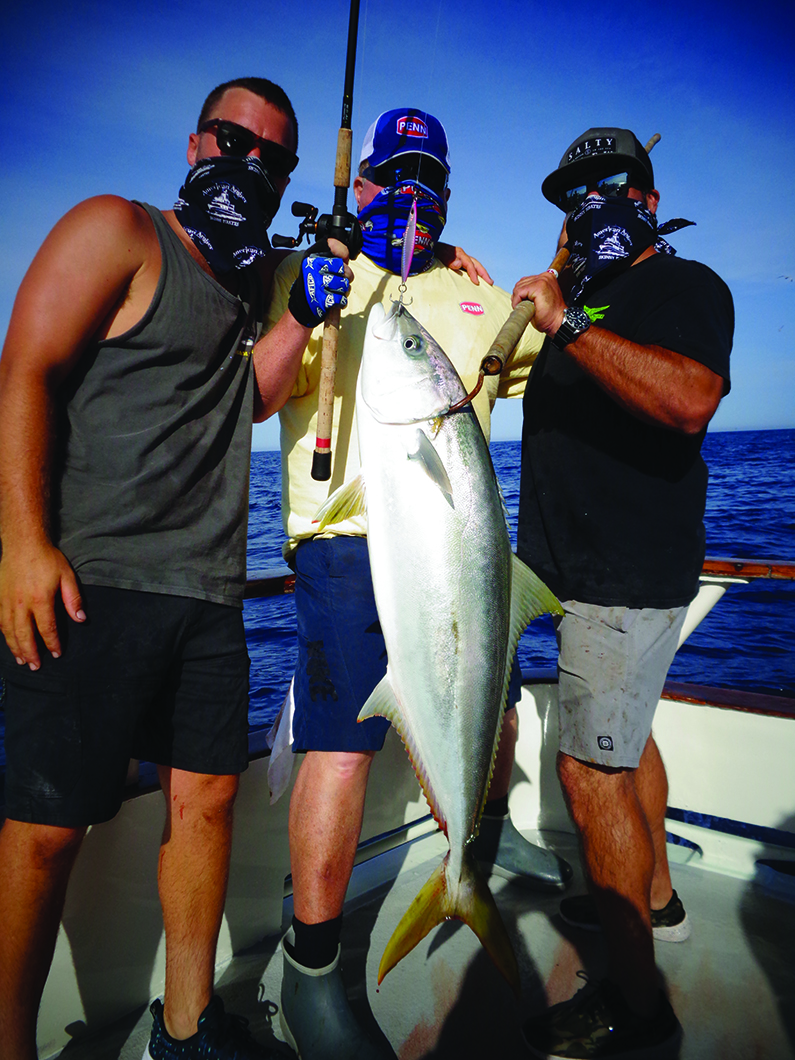 TACKLE TIPS
TACKLE TIPS
The monster 150-plus pound bluefin tuna were landed on the boat’s extra-heavy kite rigs, but a few 90-100 pound bluefin were caught on fall-type jigs fished on PENN Fathom FTH40NLD2 reels filled with 80-pound braid and 100-pound fluorocarbon wind-ons.
The better-grade yellowfin tuna were ranging 50-80 pounds, and hit flylined sardines fished with PENN Fathom FTH30LD2 reels, filled with 65-pound braid and 40-pound mono topshots, with a 4-foot piece of 40-pound fluorocarbon, and a #1 Owner Mutu circle hook.
The school-size 20-40 pound bluefin were especially finicky, and the standard-issue setup was a PENN Fathom FTHII15SD star drag reel filled with 30-pound braid and a 20 or 25-pound mono topshot, tipped with a 5-foot piece of matching fluorocarbon and a tiny #2 Owner Gorilla Light J-hook.
Both yo-yo iron and surface iron scored yellowtail early in the trip. Most productive of all was a blue/white or scrambled egg-color Tady 4/0 fished yo-yo style; simply dropped straight down all the way to the bottom, and cranked back up at warp speed. Those anglers choosing to throw surface iron did well with Tady 45’s in mint color, cast in the vicinity of boiling fish.
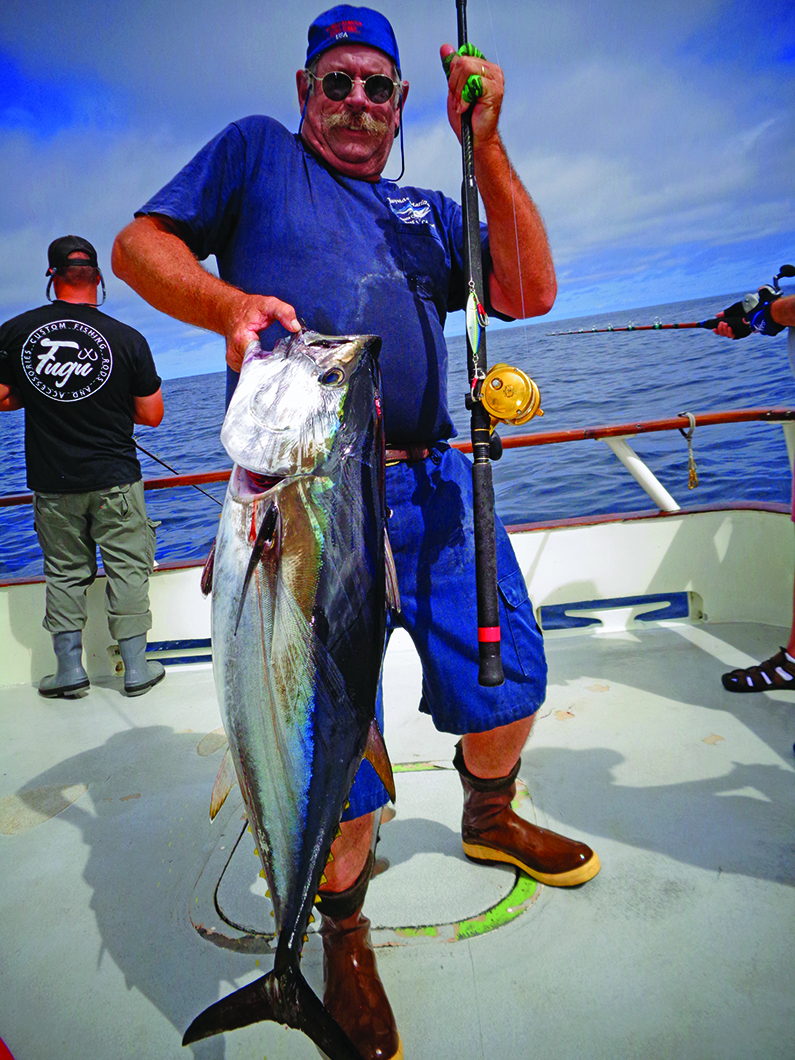 JACKPOT WINNERS
JACKPOT WINNERS
Although “kite fish” do not count in the jackpot, some absolute monsters were caught with it, and merit mention here. The biggest of all was the monster 265-pound bluefin landed by Gordon Profft. Next up was the 179-pound bluefin by Steve Weber, and a 172-pounder by Joe Bailey. Walt Bailey was not far behind with a 157-poud specimen.
The overall jackpot honors were taken by Rob Mitchell’s beautiful 100-pound bluefin tuna, which earned him a PENN 2-speed reel and a nice tuna plaque. In second place was Joel Golding’s 98-pound bluefin, and followed closely by Steve Wann’s 94-pounder.
The Owner Hooks “First Fish” awards went to George Acosta [dorado], and Walt Bailey managed to get both the first tuna, and the first yellowtail prizes. The “Hero Fish” award naturally went to Gordon Profft’s cow bluefin, and the coveted Costa “Mr. Congeniality” prize as voted by the crew of the American Angler, was awarded to Steve Monnig.

